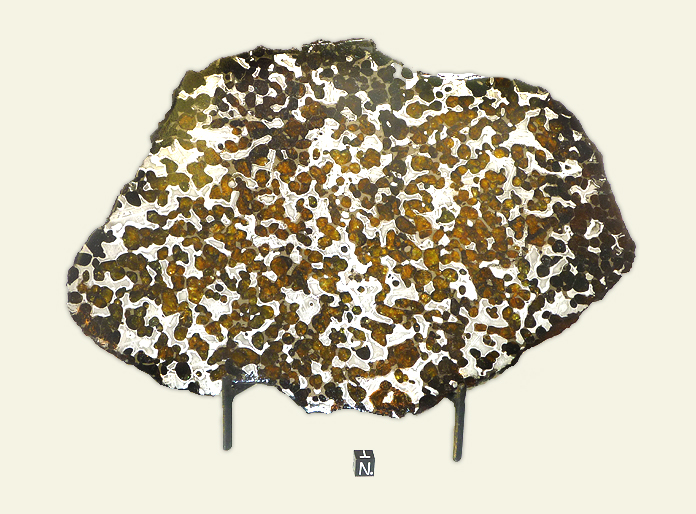
 |
BRENHAM The Brenham Meteorite Find In February of 1882, Frank Kimberly and his wife Eliza recorded a homestead claim in Kiowa County, Kansas. Eliza began to find unusually heavy rocks that she believed to be meteorites. She began a collection of the rocks, (1) named "Moon Rock" - 466 pounds, (2) one described as arch-shaped - 345 pounds, (3) one found in the neighbor's field - 35.72 pounds. There were more than twenty rocks in her collection estimated at slightly above 2000 pounds total weight. For years she sent letters describing the unusual stones to colleges and universities in an effort to document her finds. Finally on March 13, 1890 F. W. Cragin, a professor at Washburn College in Topeka traveled the long journey to the Kimberly farm in Kiowa County. Cragin was a Harvard trained scientist with special interest in geology. Upon examining the specimens he determined that he was looking at a rare type of meteorite - a pallasite - that would be a great treasure for scientific study. Eliza walked with Professor Cragin over some areas of the farm to point out locations where different specimens had been found, but the time was limited and there were interesting significant spots he did not see. One had been described as an old "buffalo waller", wider and deeper than most, which always held rainwater longer than others had. The prairies were dotted with these small depressions in the ground. But, in this particular one the family had found numerous fragments of meteorite material. Brenham was the name of the town closest to the meteorite find; thus the find was named Brenham. Brenham did not survive the competition of nearby new towns of Haviland and Greensburg and it was soon abandoned. Eliza predicted that other scientists would be after the rocks. This prophecy was fulfilled sooner than expected. The very next day, Professor Hay a field geologist paid a visit to the farm. He surveyed the area, mapped the location where many of the masses had been found and made a sketch of the farm home and surroundings. This information proved useful in determining the total size of the shower and the angle and direction of entry. The following Monday, Professor Snow Chancellor of Kansas University arrived to visit the farm. He was able to obtain one Brenham meteorite during that first visit. He reported its weight as 101.5 pounds and he purchased it for $150.00. Brenham Meteorite Crater The number and weight of Brenham meteorites found has been much greater than estimated in 1890. In the 1920's an energetic young science teacher from McPherson College, McPherson, Kansas discovered a depression about the size of a buffalo wallow that had been overlooked in earlier observations. Eight years passed before the Kimberly family granted Nininger permission to make a scientific investigation. Many fragments were found in this crater but to their disappointment no large meteorite was found. However about one half mile from the crater a small aerolite in no respect similar to other Brenham meteorites, except possibly in the matter of age was found. It may have been an accompanying satellite of at the large mass of the Kiowa County pallasite or it may simply be an overlapping fall. The Space Wanderer H. O. Stockwell of Hutchinson, Kansas attended a lecture on meteoritics given by H. H. Nininger and thereafter centered his spare time studies on meteors and meteorites. He designed a wheelbarrow - mounted detector. He believed there might be a few good specimens of the Brenham meteorites buried deeper than plow depth. None of the early investigators had any knowledge of modern metal detectors. By this time the former homestead of Frank & Eliza Kimberly was owned by Mr. & Mrs. E. Peck. Stockwell was thrilled to find a meteorite about fourteen inches below the surface and about one-foot in diameter. He continued to search the area for almost two years. In the spring of 1949 the biggest one yet was found deep in the ground. Excavating by hand labor was tiring and continued for several hours. By evening the meteorite stood free in an opening six feet deep and about seven feet in diameter. Raising of largest Brenham meteorite in 1949 Early the next day, the Peck's one and a half ton farm truck was backed into position near the cavity where the meteorite still stood on end, as it had through the ages concealed by a cover of soil. A fourteen-foot iron beam (salvage from an old wheat combine) was set vertically on the ground and anchored to the rear of the truck. A chain hoist was attached to the shaft and all was ready to bring the "Space Wanderer" out of the ground. A photographer from Greensburg was there and Myron Kimberly, the son of Frank & Eliza Kimberly. He had helped his mother as she first began collecting meteorites in the Brenham fields and lived to help remove the largest pallasite ever recovered. The stone was taken to a nearby grain elevator for weighing where it tipped the scale at 1,000 pounds. The stone proved to b a pallasite specimen of good quality. This last find brought the aggregate weight of Stockwell's discoveries to 2,733 pounds. Stockwell felt that because of the history and size of the "Space Wanderer" that the stone should not be cut into sections but be exhibited intact. The pallasite was placed in the Greensburg Big Well Museum in 1949, where it has been on display and is seen by many thousand tourists each year. In 1997 over 50,000 tourists stopped at the Big Well to see the "Space Wanderer." |

Sold
More large pieces avail, please contact for details
| For ordering information please
click HERE |
| HOME
|||
METEORITES
FOR SALE |||
CONTACT
& ORDERING
|||
SERVICES
|||
COLLECTION |